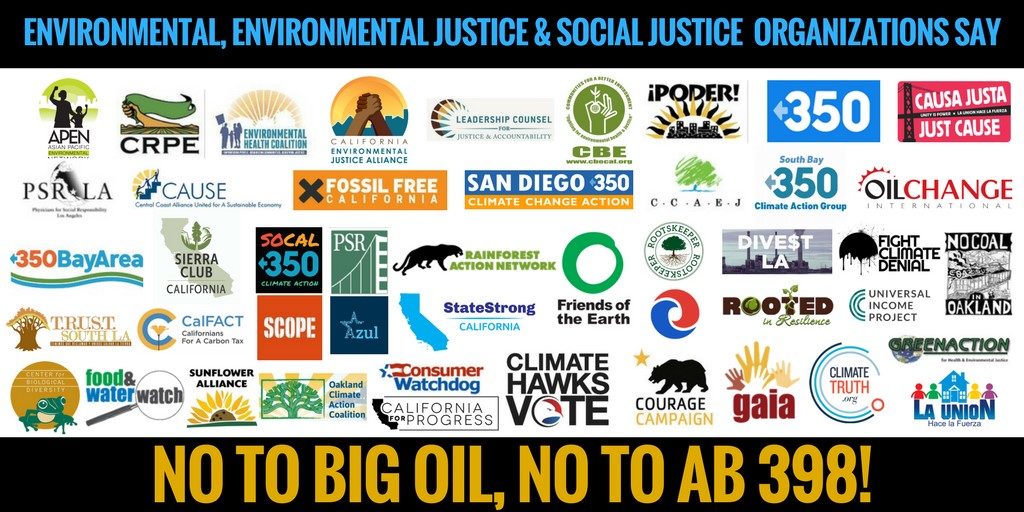California extended its Cap and Trade system until 2030, symbolic “climate change” legislation that instead of limiting CO2 emissions actually allows grave concessions to the oil industry. It ties the hands of local agencies ability to regulate greenhouse gases, and threatens both the state’s climate goals and the health of communities, ecosystems, and the planet. RL Miller unveils the ugly political process where Jerry Brown had the oil industry write the bill and forced the rest to go along.


Something, Anything: How California’s Cap And Trade Got Extended, in Three Political Acts
By RL Miller, Published by DailyKos
Act One: The Plot
Opening Scene: A law firm office, April flowers blooming outside the window. Close up on a document showing what Western States Petroleum Association wants in any deal to extend cap and trade. A smooth legal voice explains that Big Oil really wants to extend cap and trade, currently expiring in 2020, out to 2030: it’s good for California, it’s good for market certainty. All we ask for is the ability to use up our free allowances we’ve stockpiled over the last few years in the complicated auctions, oh and we don’t want local air quality districts regulating us, that’s perfectly reasonable, isn’t it? And if the poor brown people complain about pollution we’ll throw them a bone – local monitoring of pollution other than greenhouse gases – and call it good.
Credits roll over a montage, as April turns into May and May turns into June. California Governor Jerry Brown says he’s negotiating with Big Oil. He says he’s negotiating with Republicans. But no one knows what he’s negotiating.
Scene 2: My computer. Someone gives me three documents – Governor Office Proposals 1, 2, and 3 – all dated June 2017. A little while later, the original document – the lawyers’ WSPA wish list dated April 2017, also shows up. My face blanches in horror as I realize that they’re all the same thing. Yes, the governor has been taking his negotiating points on California’s signature climate change initiative from Big Oil.
Scene 3: The Capitol, Sacramento. Assemblymember Cristina Garcia assembles a letter stating principles for a “good” cap and trade extension. Local air quality districts’ right to regulate greenhouse gases must continue. The scams of free allowances and far off offsets need to end. 20 of her progressive Democratic colleagues ultimately sign on to the letter.
Scene 4: I write a petition asking Gov. Brown to stop taking his climate negotiating points from Chevron that quickly reaches 10,000 signatures. In These Times also publishes a story outlining the deal and the deeper history of Gov. Brown’s complicated relationship with Big Oil. The governor’s head explodes.
Fade out, with red flecks and bits of gray matter scattered all over the screen.
“The Cap & Trade extension was written by the oil industry, is even worse than the current failed program, includes pre-emptions from local action, gives away so many free credits we will never meet climate goals, and allows oil refineries to expand indefinitely with no program for Just Transition to clean energy that is so desperately needed in EJ communities,” says Julia May, senior scientist at Communities for a Better Environment (CBE).
CBE Study: State Gift to Big Oil Keeps Pollution Profitable Under “Cap-and-Trade”
Act Two: The Bill
Scene 1: The Capitol. Jerry Brown, his head hastily put back together, vows to get the bill passed with Republican votes.
Cut to: My computer. Drafts dated July 1, July 3, and July 5 are leaked to me. All of the drafts keep the same points: free allowances, prohibition on local air quality district regulation. New side deals to attract Republicans emerge.
Scene 2: Back to the Capitol. Paid lobbyists for green groups, all white people, make the rounds. Each conversation starts: “Yes, this deal sucks, but we need to pass something. Anything.”
Just outside the Capitol, unpaid activists, brown and black and white people, look on in horror. The proposals keep a key tenet: a cap-and-trader can pay for offsets somewhere in the world. A rain forest in Brazil, an Arkansas rice farm – it’s all the same in global climate pollution; but it doesn’t clean up pollution at home. What has happened to California Democrats who say they care about environmental justice???
Scene 3: Orange County. Jon Fleischman, a California Republican Party official and the editor of Breitbart California, rails against cap and trade extension.
Scene 4: Stanford University. Earnest economists crunch numbers and realize that the oil companies have so many free allowances accumulated during the 2015-17 era that they will never reach the cap. And it’s highly likely with all that hot air, that the state will never reach its 2030 climate goal. But the Governor wants to pass something, anything.
Scene 5: My phone, late at night, almost every night. Texts: The governor is negotiating with industry but cutting out environmentalists! California chapter of national green group wants to oppose bill, but Brown calls national HQ and national HQ orders support! The bill is getting worse! HELP!
I track support and opposition. Ultimately, I help assemble a coalition of 65+ groups opposed to the bill – environmental justice advocates, climate groups, progressive groups. We all know that we cannot let the legislature approve a climate bill literally originating with a Big Oil wish list. Meanwhile, 10 or so green groups, almost all of whom have paid lobbyists inside the Capitol and who have seen up close and personal the power of Big Oil, support the bill, repeating their mantra: “it sucks, but we have to pass something, anything.”
“AB 398 is a big step backward for California’s climate leadership and environmental justice communities… We are deeply concerned about the role Big Oil has played in drafting this legislation behind closed doors. AB 398 ties the hands of the California Air Resources Board and likely makes it impossible for this agency to accomplish our mandate, which is to reduce greenhouse gases to 40% below 1990 levels by 2030. As our largest sources of greenhouse gases in the state, limiting regulations on refineries will drive up prices on all cap and trade entities and increase pressure on other facilities and sources of pollution. It also weakens the legislative gains made by AB 197 by constraining the ability of the Air Resources Board to prioritize direct emission reductions. If California is to maintain our climate leadership, we need a program that helps us achieve our 2030 targets, not hinders that ability.” — Amy Vanderwarker, Co-Director of California Environmental Justice Alliance
STORY: People’s Climate March in LA Harbor Highlights Tesoro’s Dangerous Operations

11 out of the Senate’s 13 Republicans sign on to a letter opposing AB 398, probably at the urging of Jon Fleischman. The bill needs 27 votes in the Senate; there are 27 Democrats and 13 Republicans. My state senator assures me, patronizingly, that the bill is dead so it’s ok if Dems vote for it, and don’t worry your pretty little head about market complexities, okay?
A weird hypnosis sets in at the Capitol. “Market certainty,” recite pro-AB 398 advocates. “Market mechanisms.” “The market works.” Fade out to the sound of white people chanting “market, market, market” in unison.
“Recognizing that the regulatory approach of the state was not working for our local communities, we worked directly with the Bay Area Air Quality Management District to produce some of the most groundbreaking rules to date around refinery emissions. With AB 398, those rules are now at risk. Residents living near the Chevron Refinery in Richmond are upset that their ability to make decisions about our air quality is now being preempted by the state. Overall this is a missed opportunity by California to lead the world in an equitable approach to address the immediate health impacts of local pollutants and advance an equitable approach to actually reduce the risk of climate catastrophe.” — Miya Yoshitani, Executive Director, Asian Pacific Environmental Network
This isn’t about some cockamamie legacy. This isn’t for me, I’m going to be dead. It’s for you & it’s damn real #ExtendItNow #CapandTrade ? pic.twitter.com/dAs5GD40Sz
— Jerry Brown (@JerryBrownGov) July 13, 2017
Act Three: The Vote
Scene 1: The Capitol. Republicans unveil their final demand: a Constitutional amendment designed to wreak maximum mischief. It needs voter approval in the June 2018 primary – in other words, it’s designed to drive Republican voters to the polls. It will require cap and trade spending to get a 2/3 legislative supermajority vote in 2024, long after Brown is out of office and in direct contravention of Proposition 25, a ballot initiative approved by the voters to require a simple majority, not a 2/3 supermajority, for spending. Surely this demand goes too far? But Brown is fine with it, if that’s what it takes to pass something, anything.
Scene 2: A hearing room. Brown makes a fiery, newsy speech, telling the legislators that climate change is a threat to organized human existence (true) and therefore they have to pass AB 398 (false). All eyes turn to two progressive Democratic Senators perceived to be in the “this bill sucks” camp. Will they, or won’t they? They vote for the bill, signaling to Democrats that they all need to fall in line. Indeed, one later declares that he believes in AB 398. The market, you know.
Scene 3: Outside the Capitol, the morning of the vote. Dueling press conferences – I speak at a press conference organized by Courage Campaign; pro-AB 398 groups hold a separate press conference.
Legislators tell me that they’re under immense pressure to pass this bill. “It sucks, but…” The French ambassador wants it passed! The market will fail if we don’t pass this bill! Other countries will back out of the Paris agreement if California doesn’t pass this bill!
Scene 4: The Senate passes the bill, 28-12. One Republican, bribed by last minute concessions to agriculture, crosses over.
The Assembly passes the bill, 55-21, with a few Republicans voting yes and a few progressive Democrats voting no. Thanks progressive hero Mark Stone! Thanks progressive champion Monique Limon! Thanks vulnerable Democrats Sabrina Cervantes and Sharon Quirk Silva! Donate $3.98 to express tangible thanks!
Brown and leaders congratulate each other. Sure enough, they’ve passed something, anything, and it sucks. Accolades pour in for the governor’s negotiating skills from across the country and the world. Only those paying close attention to Capitol politics know that it’s yet another win for Big Oil. Not the climate. Not the lungs of California’s poorest communities.
Fade out: I drive past wildfires down I-5 into the smoky sunset as the credits roll.
RL Miller is the President of Climate Hawks Vote Political Action, the Climate Hawks Vote Super PAC. RL is the elected chair of California Democratic Party’s environmental caucus. RL is an active climate blogger and organizer. Past work has included exposing the politics of climate denial and opposing fracking for oil in California, as well as advocacy and organizing on behalf of clean-economy legislation. RL earned high honors in political science at UCSD for writing a thesis on coal exports, and a law degree from UC Davis.













Pingback: Winds and Wildfires, On Overcoming California Climate Chaos | WilderUtopia.com